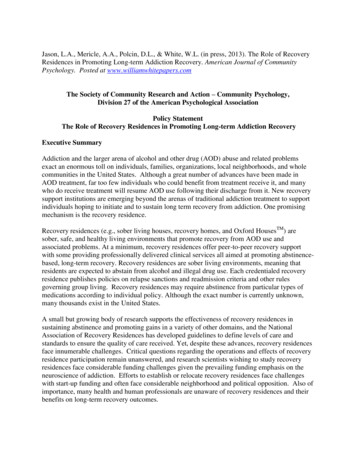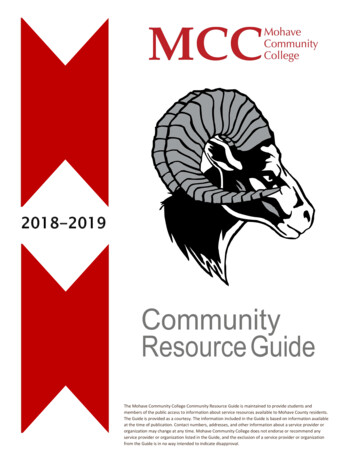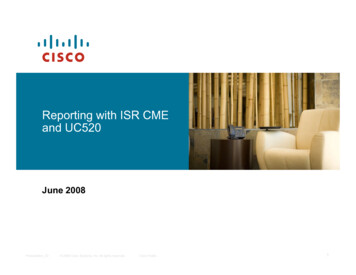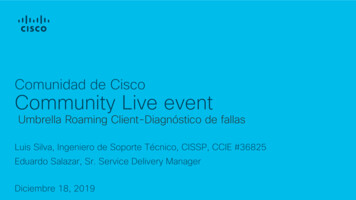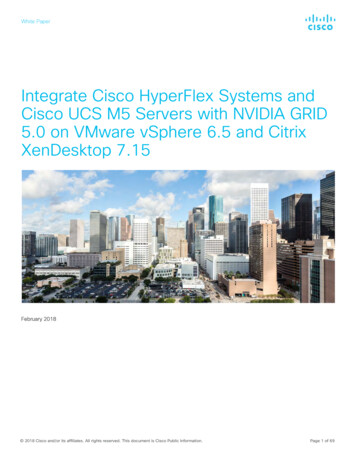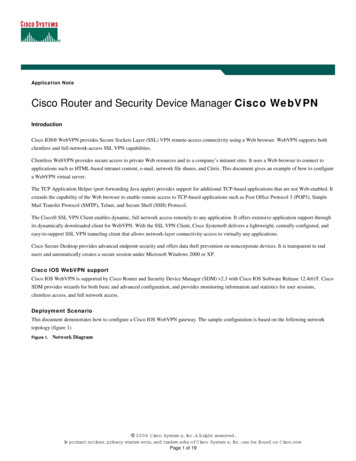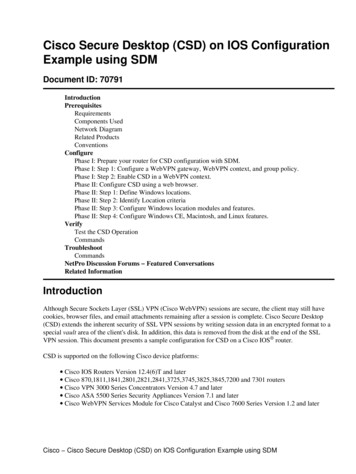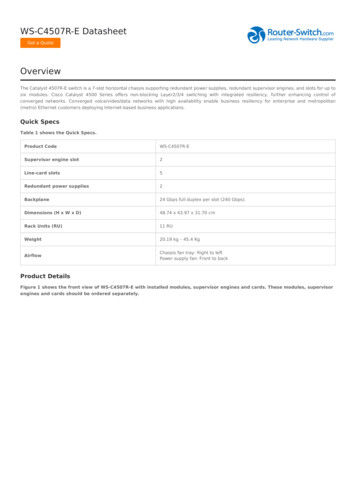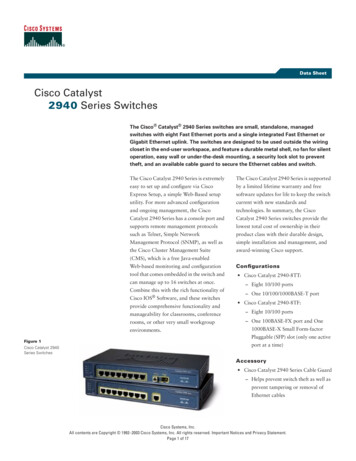
Transcription
IntroductionThis document provides guidelines for implementing VRU transfers with Outbound (SIPbased) in Cisco UCCE with Cisco CVP environment. This document only serves as aguide, and does not cover all situations.RequirementsCisco recommends that you have knowledge of these topics: Cisco UCCE (with Outbound Feature)Cisco CVPCisco GatewaysComponents UsedThe information in this document is based on these software versions: Cisco CVP 8.0(1)Cisco UCCE 8.0(2)Cisco Gateway IOS 15.1(1)TThe information in this document was created from the devices in a specific labenvironment. All of the devices used in this document started with a cleared (default)configuration.Helpful Suggestion:As Outbound and CVP are complex features and products. It is suggested to configurethem separately and then use this document to understand the bigger picture on stepsrequired to integrate the products together.Call Flow Abstract: Outbound contacts are loaded in the configuration.Campaign Manager sends the contacts to the dialer to be called.Dialer places the call via the gateway which detects voice.Dialer via Media Routing PG sends NEW TASK to ICM.ICM does translation routing and sends label to MR PG for the dialer to setup callto CVP via gateway.CVP accepts the call and requests instruction from ICM for voice treatment.ICM sends Temporary Connect to setup VXML call leg.CVP sends another Request Instruction and receives instructions from ICM.Cisco PDI [http://www.cisco.com/go/pdihelpdesk]Page 1
Outbound Configuration:Complete the necessary steps in order for the Outbound dialer to place a call to thecontact. Please refer to the Outbound configuration guide for reference. Set the ‘After AMD and for transfer to IVR campaign’ to UCCE DN associateassociatedwith MR PG. This will send the initial NEW TASK message to UCCE fortranslation routing to CVP.DIALER:(IVR) --- Dialing, phone: [4692550295], port: 000, ring timeout: 32, state:PORT DEVICE ATTRIBTrace: initialRequest - SipReq: INVITE 4692550295@14.128.128.224692550295@1cid 1309064d-ce63f018ce63f018e13a9b54-313eb330313eb330 tid 2668d54c2a086924 cseq INVITE contact 3000 / 1 from(tu)Trace: (IVR) Transferring Customr port: 000, to IVR route point: [9998]MR PIM:Message NEW TASK; Length 197 bytesDialogueID (3) Hex 00000003SendSeqNo (1) Hex 00000001MRDomainID (1) Hex 00000001CiscoReserved (0) Hex 00000000ScriptSelector: 9998CallOriginated: DCisco PDI [http://www.cisco.com/go/pdihelpdesk]Page 2
Figure 1 – Outbound: Campaign Configuration:ICM Configuration:Complete these steps in order to set and return Translation Route label (UCM CTI RoutePoint) from ICM to IPIVR via UCM:1. Define a Network VRU as Type 2 or Type 102. Configure MR peripheral with Post Routing enabled and select the Network VRUas defined in step 1 under Advanced tab.3. Define Service for the VRU peripheral and a route.4. Define Network VRU Scripts.Cisco PDI [http://www.cisco.com/go/pdihelpdesk]Page 3
5. Define Network Trunk Group and Trunk Group for VRU PG. Choose the VRUrouting client in Trunk Group and set the Peripheral number to 200. (It needs tomatch in the CVP configuration)Figure 2 – ICM: Service Configuration:Figure 3 – ICM: Network Trunk Group Configuration:6. Define the Translation Route.Cisco PDI [http://www.cisco.com/go/pdihelpdesk]Page 4
Figure 4 – ICM: Translation Route Configuration:Based on the ICM configuration, it will return a label which is defined in the CVP.MR PIM:Message DO THIS WITH TASK; Length 214 bytesDialogueID (3) Hex 00000003SendSeqNo (1) Hex 00000001IcmTaskID 149738:53708400: 1SkillGroup UndefinedService (5023) Hex 0000139fAgent UndefinedAgentInfo:Label: 3001DIALER:14:58:23 Trace: (IVR) MR target acqusition succeeded for port: 000, state: GET TARGET,target: 300114:58:23 Trace: (SIP) Transfer, port: 000, phone 3001Cisco PDI [http://www.cisco.com/go/pdihelpdesk]Page 5
Gateway Configuration:dial-peer voice 3000 voipdestination-pattern 3.session protocol sipv2session target ipv4:14.128.92.123:5060voice-class codec 1voice-class sip rel1xx supported "100rel"dtmf-relay rtp-nte h245-alphanumeric h245-signalCVP Configuration:Once the CVP receives the call from gateway, it will request for instruction from the ICMvia VRU PG. Complete the following steps to configure the CVP.1. Define Translation Routed DNIS Pool to the number of ports available for translationrouting. The Pre-routed Cal Trunk Group ID needs to match the Peripheral Numberdefined in Figure 3.Figure 5 – IVR: Call Control Group Configuration:Cisco PDI [http://www.cisco.com/go/pdihelpdesk]Page 6
Following is the CVP (VRU) pim logs showing CVP requesting instruction from ICM forthe call and receiving instruction on setting up call leg with VXML gateway.VRU- PG: Service Control Message ( Message Type 47); Message Length 100 bytesRequest Instruction ( Subtype 6); DialogueID: (57) 00000039;SendSeqNo: (1)00000001Trunk Group ID: (200) 000000c8Trunk Number: 0Service ID: (2) 00000002ANI: 4692550295DNIS: 3001Call GUID: 0AB988E31000012D374714F40E805C7BPSTN Trunk Group ID: 14.128.128.22PSTN Trunk Group Channel Number: (2147483647) 7fffffffPG- VRU: Service Control Message ( Message Type 47); Message Length 99 bytesTemporary Connect ( Subtype 30); DialogueID: (57) 00000039;SendSeqNo: (1)00000001Label: 7778889999CorrelationID: 2RouterCallKey: (53708400) 03338670RouterCallKeyDay: (149738) 000248eaRouterCallKeySequenceNumber: (0) 00000000Call GUID: 0AB988E31000012D374714F40E805C7BVRU- PG: Service Control Message ( Message Type 47); Message Length 110 bytesRequest Instruction ( Subtype 6); DialogueID: (58) 0000003a;SendSeqNo: (1)00000001Trunk Group ID: (200) 000000c8Trunk Number: 1Service ID: (2) 00000002ANI: sip:4692550295@14.128.92.123:5060DNIS: 7778889999CorrelationID: 2Call GUID: 0AB988E31000012D374714F40E805C7BPG- VRU: Service Control Message ( Message Type 47); Message Length 123 bytesRun Script Req ( Subtype 7); DialogueID: (58) 0000003a;SendSeqNo: (1)00000001Invoke ID: (1) 00000001Script Name: PM,pleasewait.wavScript Configuration:RouterCallKey: (53708400) 03338670RouterCallKeyDay: (149738) 000248eaRouterCallKeySequenceNumber: (2) 00000002Call GUID: 0AB988E31000012D374714F40E805C7BCisco PDI [http://www.cisco.com/go/pdihelpdesk]Page 7
Additional Notes:ICM Router:Trace: (3 x 0 : 0 0) NewCall:CRSCallID (149738,53708400) dn 9998 ani ced Trace:RCID 5007 RCKSeqNum -1 MRDomainID 1 OpCode 0 CallAtVRU 1 NICdn Trace: TranRouteToVRU: 5023 1 5023Trace: (3 x 0 : 0 0) TranRouteToVRU: Label 3001 CorrelationID 1 VRUID 5001Trace: (3 x 0 : 0 0) Correlation id for dialog is (1).Trace: Dialog (57) has a PeripheralTarget correlationID (P5035) mapped to correlationID 1.Trace: (3 57 1 : 0 0) RequestInstr: CRSCallID(149738,53708400) callstate 1.Trace: (57 57 1 : 0 0) Dialog initiating 2nd phase of transfer.Trace: (57 57 1 : 0 0) Correlation id for dialog is (2).Trace: (57 57 2 : 0 0) TransferToVRU: Label 7778889999 CorrelationID 2 VRUID 5001Trace: (57 57 2 : 0 0) TransferConnect sent. Dialog pending.Trace: (57 58 2 : 0 0) RequestInstr: CRSCallID(149738,53708400) callstate 1.Trace: (57 58 2 : 0 0) Dialog resuming (Request Instruction received.) status (0)Trace: (57 58 2 : 0 0) Runscript sent. Dialog pending. ICM sample script:Alternative Approach:If preserving and passing ECC variables is not required, a default label can be set in theICM which the dialer will use to transfer the call to CVP via the gateway. There is noextra configuration required on the CVP and every call will appear to the CVP/UCCE asa new call.Cisco PDI [http://www.cisco.com/go/pdihelpdesk]Page 8
Dec 02, 2011 · Outbound contacts are loaded in the configuration. Campaign Manager sends the contacts to the dialer to be called. Dialer places the call via the gateway which detects voice. Dialer via Media Routing PG sends NEW_TASK to ICM. ICM does translation routing and sends label

